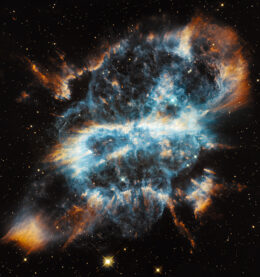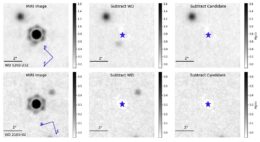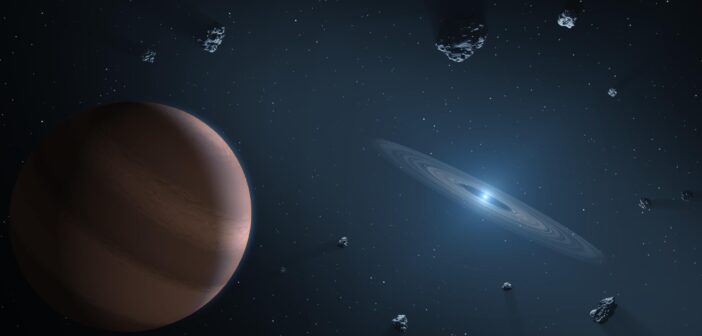JWST has directly imaged what appear to be two giant exoplanets in orbit around white dwarf stars. This discovery has important implications for the fate of giant planets in our solar system as the Sun evolves into a red giant and eventually becomes a white dwarf.

A planetary nebula appears briefly during the life cycle of most stars, including those like the Sun. Planetary nebulae tend to appear round or elliptical, but they can have dramatically varied shapes, like NGC 5189 shown here. [NASA, ESA, and the Hubble Heritage Team (STScI/AURA)]
The Fate of Most Stars
While brilliant supernova explosions demand our attention when they burst onto the scene, the vast majority of stars will end their lives more quietly, lofting their outer layers into space and forming a glowing planetary nebula that surrounds the star’s exposed core. The core, now a white dwarf containing roughly the mass of the Sun in a sphere roughly the size of Earth, starts out extremely hot and cools slowly over billions of years.
As stars evolve from main-sequence stars to red giants to white dwarfs, it’s clear that close-in planets will meet a fiery fate: as a red giant, the Sun will swell to more than 200 times its current radius, engulfing Mercury, Venus, and possibly Earth. But exactly how the transition affects planets watching things unfold from a distance isn’t yet clear. To learn more, we’ll need to study planets that survived the transformation, and recent observations with JWST may have revealed two planets that fit the bill.
Investigating Metal-Polluted White Dwarfs
Only a handful of planetary-mass objects have been discovered around white dwarfs, but many more are thought to exist; 25–50% of seemingly solo white dwarfs show metals in their spectra, which suggests that they’re collecting cast-off material from unseen planets or asteroids. If giant planets are common around these “metal-polluted” white dwarfs, it would suggest that 1) these planets are able to survive their home star’s red giant phase, and 2) they play a role in gravitationally nudging material toward the white dwarf.

The two white dwarfs and their candidate planets. The object in the upper-left corner of the top row of images is a galaxy. [Mullally et al. 2024]
Potential Planets on Outlying Orbits
The observations show a reddish object near two of the white dwarfs. If these objects are indeed planets and the same ages as their host white dwarfs (5.3 and 1.6 billion years old), they likely have masses of 1–7 and 1–2 Jupiter masses, respectively. They’re currently orbiting at estimated distances of 11.47 and 34.62 astronomical units (au), which correspond to orbital distances of 5.3 au and 9.7 au when their host stars were on the main sequence — similar to the present-day orbital distances of Jupiter and Saturn.

A comparison of the ages and orbital separations of the two new planet candidates (red triangles), the four giant planets in our solar system (blue stars), and objects with masses less than 12 Jupiter masses discovered previously through direct imaging (black circles). Click to enlarge. [Mullally et al. 2024]
If future JWST observations show that these white dwarfs and their candidate planetary companions march across the sky in step, it will mark the first direct imaging detection of planets similar to the giant planets in our solar system in age, mass, and orbital distance. More than that, it will provide evidence that widely separated planets survive their host stars ballooning into red giants, and that giant planets around white dwarfs are common and help their hosts accrete metal-rich material.
Citation
“JWST Directly Images Giant Planet Candidates Around Two Metal-Polluted White Dwarf Stars,” Susan E. Mullally et al 2024 ApJL 962 L32. doi:10.3847/2041-8213/ad2348

